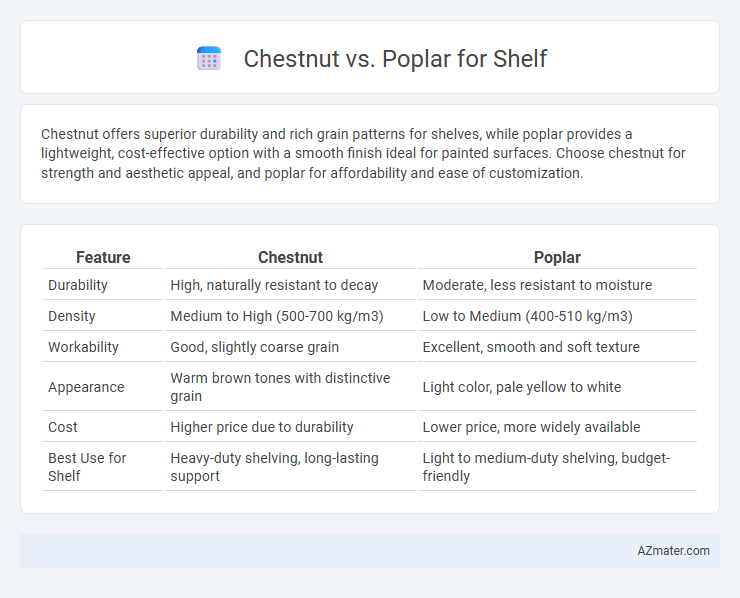Chestnut offers superior durability and rich grain patterns for shelves, while poplar provides a lightweight, cost-effective option with a smooth finish ideal for painted surfaces. Choose chestnut for strength and aesthetic appeal, and poplar for affordability and ease of customization.
Table of Comparison
| Feature | Chestnut | Poplar |
|---|---|---|
| Durability | High, naturally resistant to decay | Moderate, less resistant to moisture |
| Density | Medium to High (500-700 kg/m3) | Low to Medium (400-510 kg/m3) |
| Workability | Good, slightly coarse grain | Excellent, smooth and soft texture |
| Appearance | Warm brown tones with distinctive grain | Light color, pale yellow to white |
| Cost | Higher price due to durability | Lower price, more widely available |
| Best Use for Shelf | Heavy-duty shelving, long-lasting support | Light to medium-duty shelving, budget-friendly |
Introduction: Chestnut vs Poplar for Shelving
Chestnut and poplar are both popular hardwood choices for shelving, each offering unique characteristics suited to different design needs. Chestnut is prized for its rich, warm tones and natural grain patterns, providing durability and an attractive finish ideal for high-quality, rustic-style shelves. Poplar, meanwhile, is a lighter, more affordable wood that is easy to work with and takes paint well, making it a versatile option for custom or painted shelving projects.
Wood Grain and Aesthetics Comparison
Chestnut wood features a prominent, coarse grain with rich, warm tones ranging from light brown to deep amber, creating a rustic yet elegant look ideal for shelves that showcase natural beauty. Poplar exhibits a more uniform, straight grain with subtle color variations from creamy white to pale green or yellow, offering a smoother and more contemporary aesthetic suitable for painted or stained finishes. The choice between chestnut and poplar for shelving depends on the desired visual impact: chestnut provides a textured, organic appearance, while poplar ensures a clean, understated look.
Durability and Strength Differences
Chestnut wood offers superior durability and strength compared to poplar, making it an excellent choice for long-lasting shelves. Chestnut's dense grain structure provides higher resistance to wear, dents, and impact, whereas poplar is softer and more prone to scratches and dents under heavy use. For shelves needing robust support and longevity, chestnut is preferred, while poplar suits lighter, decorative shelving where strength is less critical.
Weight and Workability of Each Wood
Chestnut is heavier than poplar, with a density of approximately 42 to 43 lbs/ft3 compared to poplar's 26 to 30 lbs/ft3, making poplar a lighter choice for shelves. Poplar is easier to work with due to its softer texture and excellent machinability, while chestnut offers greater durability but can be tougher to cut and shape. Workability differences affect how each wood responds to sanding, staining, and fastening, with poplar generally requiring less effort in finishing processes.
Resistance to Decay and Pests
Chestnut wood exhibits superior resistance to decay and pests compared to poplar, making it a more durable choice for shelves in humid or insect-prone environments. The natural tannins in chestnut provide enhanced protection against fungi and wood-boring insects, extending the shelf's lifespan. Poplar, while affordable and easy to work with, lacks significant decay resistance and is more susceptible to pest damage without proper treatment.
Cost and Availability Factors
Chestnut wood is generally more expensive and less readily available than poplar, making it a less budget-friendly option for shelving projects. Poplar offers widespread availability and lower cost, making it a popular choice for affordable, functional shelves. The cost difference is influenced by chestnut's limited supply and slower growth compared to the fast-growing and abundantly sourced poplar.
Environmental Impact and Sustainability
Chestnut wood offers a more sustainable option for shelves due to its rapid growth rate and regenerative qualities, making it a renewable resource with a lower environmental footprint. Poplar, while also considered eco-friendly, grows faster than many hardwoods but may involve more intensive farming practices that can impact soil health and biodiversity. Choosing chestnut typically supports better carbon sequestration and less habitat disruption compared to poplar, contributing to a greener choice for environmentally conscious consumers.
Maintenance and Longevity
Chestnut wood offers superior durability and requires minimal maintenance due to its natural resistance to decay and insects, making it ideal for long-lasting shelves. Poplar shelves generally need more frequent upkeep, such as sealing or refinishing, because of their softer grain and higher susceptibility to dents and moisture damage. Choosing chestnut enhances shelf longevity with lower maintenance efforts, while poplar suits budget-friendly projects that demand regular care.
Best Uses: Chestnut vs Poplar in Shelves
Chestnut offers exceptional durability and rich grain patterns, making it ideal for decorative shelves that require strength and visual appeal. Poplar is a lightweight hardwood with a fine, uniform texture, suitable for painted shelves or structures where smooth finishes and cost-effectiveness are priorities. For heavy-duty shelving, chestnut's robustness surpasses poplar, while poplar excels in versatile, budget-friendly applications.
Conclusion: Choosing the Ideal Wood for Your Shelf
Chestnut offers exceptional durability and rich, warm tones that enhance shelf aesthetics and longevity, making it ideal for heavy or decorative shelving. Poplar is softer and more affordable, suitable for lightweight shelves or painted finishes due to its smooth grain and ease of workability. Selecting between chestnut and poplar depends on budget, desired appearance, and shelf load requirements, with chestnut excelling in strength and natural beauty, while poplar provides cost-effective versatility.

Infographic: Chestnut vs Poplar for Shelf
 azmater.com
azmater.com